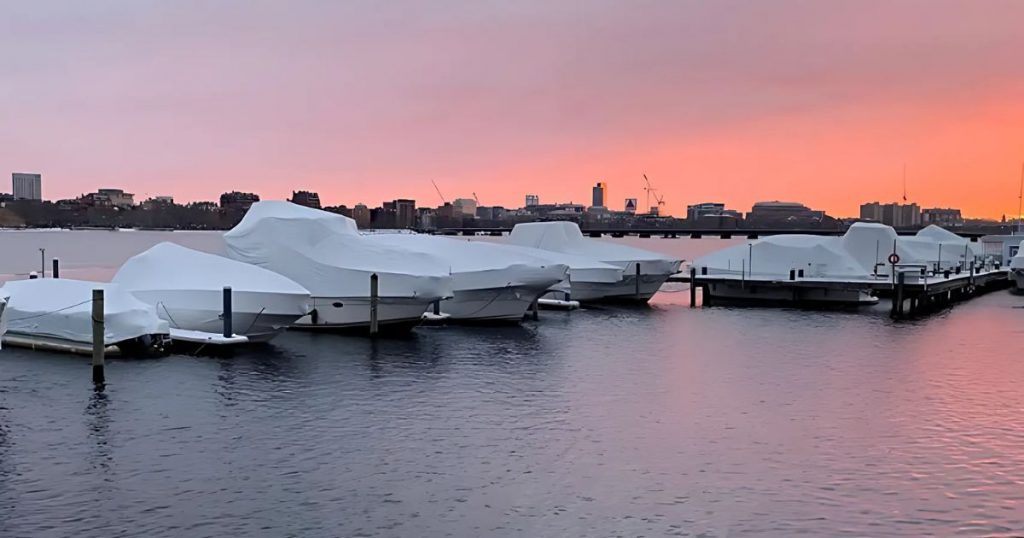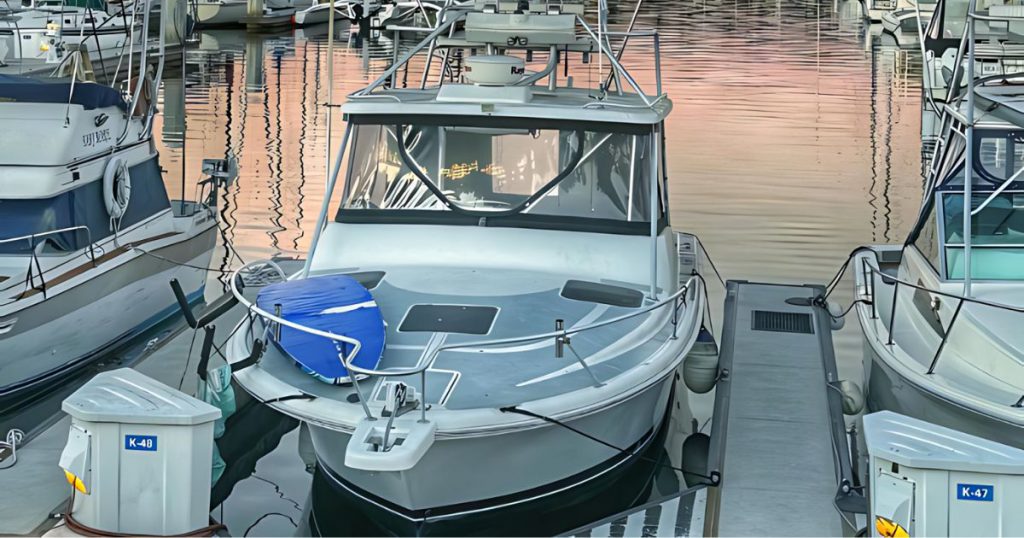
Proper boat storage can help safeguard against avoidable damage and reduce the likelihood and cost of maintenance and repair. Additionally, the right boat storage ensures that your boat is always ready to hit the water whenever you are.
When boats aren’t stored correctly, problems like engine corrosion, electrical failures, ruined upholstery, and split hoses can quickly become expensive repairs. If you choose the right storage option for your boat, you minimize maintenance headaches, extend the life of your boat, and ultimately save yourself money. Sheltering your boat shields it from UV rays, moisture, pests, and theft. Follow these expert boat storage strategies from CubeSmart to make sure your boat is ready for smooth sailing.
Types of Boat Storage Options

Storing your vessel, whether indoors, under a covered shelter, or in a secure lot, can mean easier launching, less frustration, and fewer repair bills. When choosing between indoor, covered, and outdoor storage, it’s helpful to think beyond just shelter. Consider security, cost, accessibility, and the level of inspection and maintenance you are willing to manage on your own. How much you’ll pay depends on the type of storage you choose, the size of your boat, and your location.
Indoor Storage
Indoor storage gives you the ultimate safeguard against every element. Inside a fully enclosed, climate-controlled unit, your boat has less exposure to UV damage, wind-driven rain, snow, and hail. Temperature and humidity stay steady, which can help reduce mold and rust.
This peace of mind does come at a premium, though. Depending on the location and amenities, you can expect to pay a higher price for storage. If you own a high-end cruiser, have sensitive electronics, or live where winters bite hard, then this type of indoor storage is worth the extra cost.
Covered Storage
Covered storage tucks your boat under a roof but leaves the sides exposed. This type of shelter cuts most UV exposure, helps keep hail off the deck, and can limit bird droppings. You’ll still need to guard against driving rain, intense winds, temperature swings, and humidity, though. Adding a breathable bow-to-stern custom-fit boat cover can give extra protection from these issues. This is a great choice if you head out on the water several times a month and want quicker access without the steep cost of a fully enclosed bay.
Outdoor Storage
Outdoor storage offers a place to park your boat in a lot, usually with no overhead protection. It’s a budget-friendly choice, but it relies on you to stay vigilant to avoid damage to your vessel. A high-quality, breathable cover helps to shed moisture, and parking hull-down encourages water runoff.
Ideally, you should spend time each month inspecting your cover and boat, checking for water pooling, debris, or signs of pests. If you’re handy, self-sufficient, and hit the water almost every weekend, outdoor storage is a great option. Just be prepared for more hands-on upkeep. If, for example, you want to plan a last-minute getaway to the East Coast and you’ve kept your boat in perfect condition in outdoor storage, you can get sailing with no delays.
Key Features to Look For in a Boat Storage Facility

Not all boat storage facilities are the same. Therefore, it’s essential to know what to look for before entrusting your vessel to any service provider.
Security Measures
Security should definitely top your list. You want a facility equipped with video recording and remote gate access. The fewer entry points and more measures taken mean the less chance you have of facing vandalism or theft.
Climate Control
Climate control and ventilation can save you on maintenance and repairs. If temperatures fluctuate significantly, condensation can form on metal surfaces, leading to rust. As humidity rises, mold and mildew can attack canvas, carpets, and upholstery. A climate-controlled unit can maintain steady temperatures and moisture levels. That stability helps reduce corrosion and prevent the development of musty odors.
Accessibility and Convenience
Accessibility matters more than you might think. Look for facilities with extended hours so you can launch early and return late. Wide aisles and drive-up bays can help make hitching easier, especially if you’re solo. Online reservations and billing let you manage your account from anywhere. Finally, choose a location close to your favorite launch ramp or your home. Cutting a 30-minute round trip down to 10 minutes adds up fast over the season.
Don’t overlook perks like covered loading docks, drive-up prep areas for cleaning.
Maintenance Tips Before Storing Your Boat

Before you button up for the season, walk your boat from bow to stern looking for minor dings, loose hardware, or tiny cracks. All of those little imperfections you noticed when you were out having fun, you put to the back of your mind. Fixing those now, even if it’s just tightening a rail mounting or getting a gel coat repair kit, can help save them from turning into significant issues that’ll cost you more time and money next season.
Clean and Dry Every Surface
Start by rinsing off salt, algae, and grime with fresh water. Follow with a marine-grade soap and a soft brush to lift stubborn spots. Open every locker and hatch to allow air to circulate. Moisture trapped in the bilge or compartments can develop into mold and mildew within days. It’s also a good idea to slide moisture-absorbing packs into lockers and under cushions. These dry bags or commercial desiccant pouches can help provide inexpensive protection against mold and mildew buildup when humidity levels spike.
Polish and Protect the Finish
After washing and rinsing, apply a two-stage barrier to the finish. First, apply a marine-grade polish to seal in shine and repel dirt. Follow this up with a UV-resistant wax layer to help guard against sun bleaching.
Maintain the Engine and Fuel System
Fuel left sitting can separate and cause major issues. Top off your tank and add fuel stabilizer, then run the engine for a full ten minutes. This makes sure the treated fuel coats every passage. If you want to be extra cautious, consider renting a fuel-polishing pump to remove any old varnish before storage. Fog the cylinders with a corrosion inhibitor spray. That oily mist coats internal parts, helping keep rust at bay. A stable fuel system means a smoother, more reliable start in spring, without clogged filters and gummed-up injectors.
Care for Batteries and Electronics
Don’t forget to take care of your battery and electronics. Unsurprisingly, electronics are particularly sensitive if left unattended. Remove chartplotters, fish-finders, and stereo faceplates. Take them home to store until you’re ready to hit the open water again. If possible, remove the battery and store it on a trickle charger inside. If it must stay on board, hook up a quality maintainer to keep it topped off.
Prevent Electrical Corrosion
Corrosion on terminals and connectors is a common cause of electrical failures, so wipe them clean and apply a small amount of dielectric grease before storing them away. It’s also a smart idea to slip another couple of desiccant packs into helm lockers to soak up any stray moisture.
Seal and Cover to Keep Pests Out
Cover and seal your boat to keep pests and moisture out. Choose a breathable, custom-fit cover. Avoid using cheap tarps, as they can trap moisture and damage your finish. Seal hull drains, scuppers, and vents with plug kits or tape designed for marine use. Lubricate hinges, latches, and trailer bearings with a marine-grade spray to prevent rust and keep everything moving smoothly when you return.
Document the Boat’s Condition
Last but not least, take a photo of your hull, hardware, and trailer, dated, before you walk away. Store them in an accessible place so you can compare before and after a big storm or a long off-season. Those images make spotting new damage super simple.
Seasonal Considerations for Year-Round Storage

You need to know how to winterize a boat, even if you plan to store it indoors for the off-season. In winter, water left in lines expands as it freezes, which can cause cracks in engines and plumbing. Drain your freshwater system completely, then run non-toxic marine antifreeze through the lines. Fog your engine after draining the cooling system to protect its internal passages.
If you choose outdoor storage, consider having professionals shrink-wrap your boat. The tight plastic wrap helps prevent snow, ice, and wind from damaging your deck hardware. Just make sure moisture isn’t trapped beneath the wrapping.
Supporting your hull properly can’t be an afterthought. If you’re using jack stands, place them under factory bulkheads and brace them with stacked timbers or commercial blocks for even weight distribution. This supports the hull fully and helps prevent warping over time due to weight.
Prepping your boat for summer and hurricane season is also important, like UV protection and storm readiness. A UV-resistant wax helps your gel coat resist fading, and a sturdy cover with reinforced tie-downs helps shelter your boat from heavy rains and flying debris.
If you live in a hurricane-prone area, plan your evacuation route well before any storm warnings. Bridges and marina exits can close suddenly, so know where you’ll safely relocate your boat on short notice. Above all, store your boat above anticipated surge levels and avoid stacking it on multi-tiered racks when winds reach tropical-storm force.
Your Boat’s Safety Starts with the Right Storage
To choose the right boat storage, you’ve got to balance protection, convenience, and cost. Indoor storage offers unmatched protection against weather and pests but isn’t quite as convenient for quick launching. Covered storage helps cut UV damage, is moderately priced, and is more easily accessible than indoor storage. The tradeoff is that you still need to add a boat cover and perform regular inspections to make sure your vessel isn’t taking damage. The most cost-effective solution is outdoor storage. However, while costs are lower than other options, this type of boat storage requires far more maintenance and upkeep from you than other choices.
Plan your maintenance well before winter or hurricane season arrives. Clean and dry your boat thoroughly, protect your engine and electricals, and invest in a custom-fit, breathable cover. This way, you’ll spend far less time worrying about your boat’s condition and more time enjoying smooth sailing.
If you’re looking for boat storage, explore CubeSmart’s boat storage options. CubeSmart offers month-to-month leases at over 1,500 locations across the U.S.







